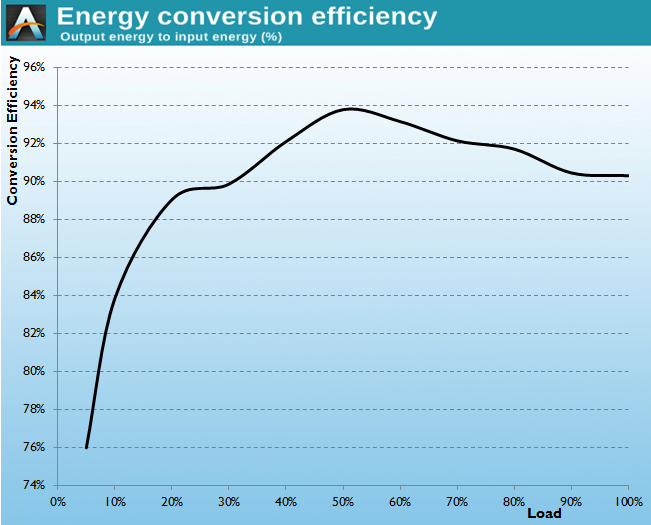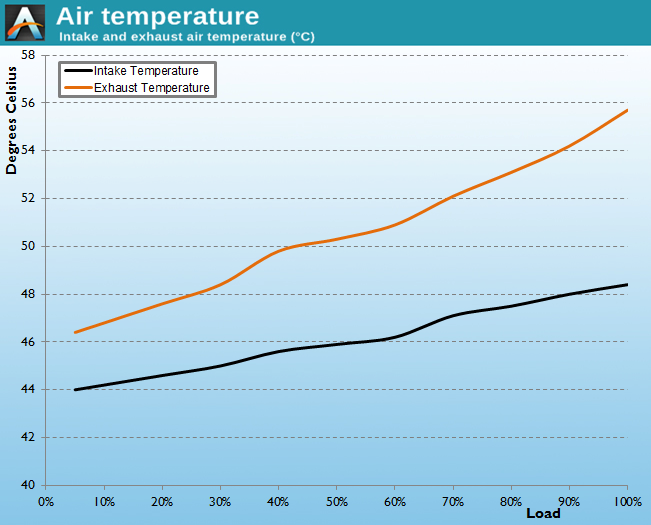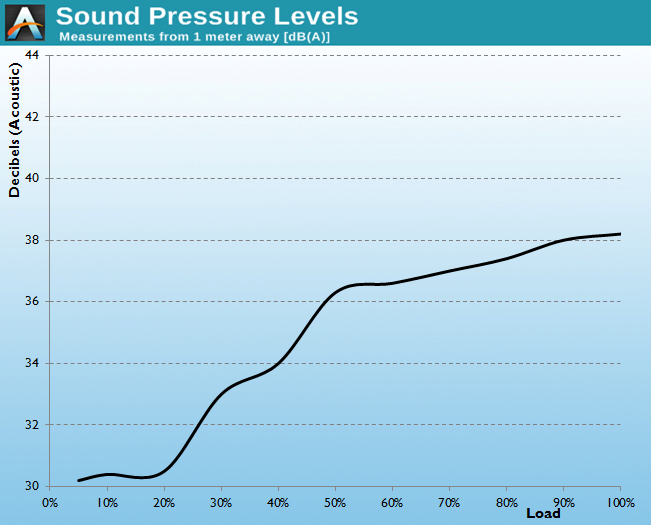Seasonic S12G 650W Power Supply Review
by E. Fylladitakis on February 28, 2014 2:20 PM EST- Posted in
- Cases/Cooling/PSUs
- Seasonic
- 80 Plus Gold
Hot Test Results
From the table below, it can be seen that the output power quality of the Seasonic S12G is very high. The maximum voltage ripple that our instrumentation recorded is a mere third of the ATX design guide suggested limit (the limits are 120 mV on the 12V line, 50 mV on the minor voltage lines), under full load and inside the hotbox no less. Cross-load testing negatively affects the power quality of any power supply but its effect on the Seasonic S12G is small, with the 12V line registering up to 54 mV while delivering 512W. Cross-load testing has virtually no effect on the minor voltage lines, the performance of which did not degrade any further than during standard testing.
| Line |
Regulation (20-100% load) |
Voltage Ripple (mV) | |||||
| 20% Load | 50% Load | 75% Load | 100% Load |
CL1 12V |
CL2 3.3V + 5V |
||
| 3.3V | 2.1% | 6 | 8 | 12 | 14 | 6 | 12 |
| 5V | 2.6% | 8 | 12 | 12 | 16 | 6 | 16 |
| 12V | 1.7% | 14 | 22 | 30 | 46 | 54 | 16 |
The impact that the higher ambient temperature has on the energy conversion efficiency is rather small, reducing the efficiency of the Seasonic S12G by about 0.5% across the entire load range. As such, the Seasonic S12G easily retains its 80 Plus Gold efficiency certification status even inside a very hot environment. The average efficiency between 20% and 100% load is an extremely high 91.6%.
The difference between our cold and hot tests is an increase of over 20°C ambient and, naturally, all of the temperature readings increase significantly. We dare say that the temperatures of the heatsinks rise quite a bit beyond our expectations of an 80 Plus Gold unit by Seasonic; however, the heatsinks are rather small and the design of the power supply apparently focuses on low-noise operation, so sacrifices are made in the area of temperatures.
The low-noise aptitude of the Seasonic S12G becomes apparent when we see that the fan hardly exceeds 38 dB(A) under the harshest of conditions, which is an audible figure but hardly louder than three or four 3.5" mechanical disks -- and never mind the GPUs that would be required to hit such loads. Nevertheless, unless you somehow manage to maintain the unit at maximum load inside a >50 °C environment, the Seasonic S12G will not get nearly hot enough to cause problems.














77 Comments
View All Comments
tynopik - Saturday, March 1, 2014 - link
> if I short the rectifier bridgeI mean on the component side. Cables can and do short and it should NOT cause permanent harm to the PSU (or to other components on other cables). If it does, the PSU is poorly designed.
> if the distibution grid around your area shifts like "a DJ is rotating the knob", which is not really possible (infinite bus theory)
The request is based off an incident that actually did happen to me. The power dipped 3 times in quick succession and the power supply blew and took out everything connected to it. Granted this was before I knew better and it was a crappy unit running right at its limit, but PSUs do have to deal with power 'variances' in the real world.
E.Fyll - Sunday, March 2, 2014 - link
Shorting a component = OCP protection. I always perform such tests before proceeding to testing the unit. I don't it that to fail catastrophically with $12.000 connected to it...I do understand that this might have had happened to you. It most likely was due to the catastrophic failure of a distribution grid's component. Still, that is not a fault of the PSU, it is an issue with your energy supplier. Your energy supplier is under contract to provide you with electricity of specific quality. If you have such severe problems with your distribution grid, you do not need a better PSU, you need a lawsuit.
HangFire - Monday, March 3, 2014 - link
I'm glad to hear you test OCP. Will you be testing it on all 3 voltage rails?As for voltage variances, they are not typically due to catastrophic failures. Quite mundane failures such as tree and animal shorts happen often, and there is a high voltage protocol to burn them off and resume normal power that sounds just like the poster's experience.
Power in proximity to manufacturing areas can show the effects of large electric motor startup and shutdown. Grids switching in and out contingent power sources can introduce phase issues, and so on.
Blowing all of these off as unusual or the result of large failure is not realistic.
HangFire - Monday, March 3, 2014 - link
Here is a good overview: http://apcdistributors.com/white-papers/Power/WP-1...E.Fyll - Tuesday, March 4, 2014 - link
It is entirely realistic, simply because a) they are unusual and b) are not a problem of the PSU itself but a problem caused by your grid.Large motors and appliances that could cause a voltage drop are not being fed by the consumer distribution grid. Anything above a medium industry is being powered by polyphase distribution. So you being in the same grid as a massive motor, no, it is not going to happen. You are connected on a distribution bus, which is nearly infinite (hence the term "infinite bus") and will no bulge even when huge generators start. If there is an appliance capable of causing a voltage surge or drop connected into the residential grid near you, that is a problem.
Trees and animals are a) not mundane failures and b) definitely not just being "burned off and resume". If an animal shorts two distribution phases and no safety kicks in, the current inbalance will easily destroy a large transformer in milliseconds.
The faults that are being described in APC's white paper certainly are correct and possible. Well, to an extend; after all, it is a paper meant to advertise how good having a UPS is, not really a scientific document. This does not mean that they are frequent, nor that they can be replicated by "rotating the knob". See these ups and downs the waveform does in their examples? Your household grid is doing 50 or 60 of them, depending on where you live, *per second*. The faults rarely have a length of more than a few milliseconds. Rotating a knob 100.000 times per second is definitely not possible, specialized equipment is required to replicate any such test.
HangFire - Friday, March 7, 2014 - link
I'm not the one suggesting the knob methodology.I would have agreed with you when I lived in the suburbs. Since moving to a rural area, I can assure you that brownouts, tree related outages and crossed power lines are quite common here. Besides trees the big threat here is drivers hitting utility poles. Very common this time of year, the combination of ice and hill country is quite hazardous, and many of the poles here carry two sets of voltages. In one event just a few years ago, every lightbulb in my house lit up very bright. I lost 5 lightbulbs and 2 small appliances.
HangFire - Friday, March 7, 2014 - link
I guess MY point is that Active PFC power supplies are supposed to take a range of voltages; but I don't see anyone testing that. I test it every few months, when I get out the 100 foot extension cord and use a PC with 5.1 speaker system for party tunes. (My guests are not picky I guess). I use quality hardware, usually a Seasonic so I'm OK but I wonder what the limits are for the cheaper stuff.tynopik - Saturday, March 1, 2014 - link
I can see where 'component side' could be confusing. I mean 'external to the power supply'. No of course I don't expect you to go digging inside a unit and shorting things out.tynopik - Saturday, March 1, 2014 - link
> the performance of a PSU in situations that will almost never arise should not influence a buying decision.it depends on what you mean by 'almost never' and what the consequences of failure in those cases are.
New Orleans is 'almost never' hit by a hurricane. Does that mean they shouldn't worry it?
Saving a few dollars a year by being more efficient in the usual case is great, but if it blows your system during a random power blip, was it worth it?
CeceliaAFolger - Sunday, March 2, 2014 - link
this is a goor site to earn $145 per Month ..........